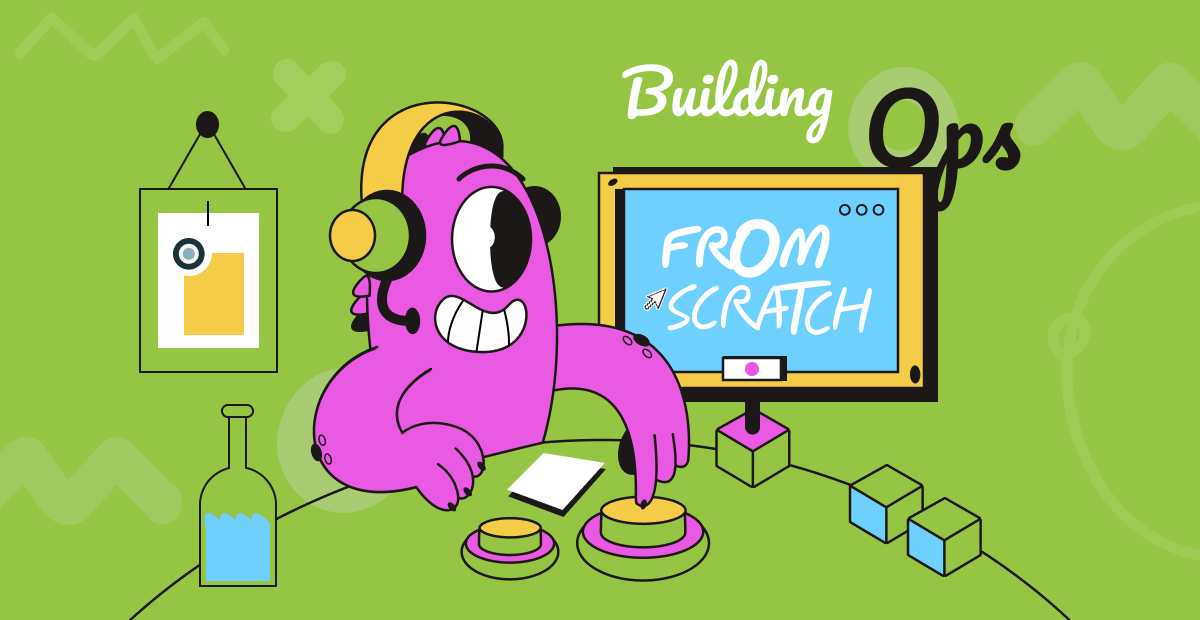Bridging silos and turning insights into impact with Ops
UX research, product, and design teams all aim to ship customer-centric products that drive measurable business outcomes. After a typical user testing session, what should happen? In a perfect world, everyone across the org hears real customer voices instead of skimming another recap deck at 11 p.m. Teams synthesize feedback, iterate on insights, and roll into the next sprint with shared clarity.
But reality loves a plot twist. Too often, teams juggle siloed workflows, scattered tools, and half-baked processes. You know that feeling when your research insights are brilliant, yet never make it past the presentation? Manual management of recruitment, incentives, scheduling, consent, and reporting stalls in spreadsheets and message threads.
Sound familiar? Great. FYI, not great because you are stuck… but because this blog unpacks how top teams transform messy, ad-hoc research into a system that scales. And no, we’re not here to rehash the same advice you’ve read, heard, or seen ad nauseam.
Whether you are a product designer, PM, UX researcher, or systems thinker, embedding scalable Ops shifts teams from reactive firefighting to proactive execution. When strategy connects with daily practice, problem identification turns into a clear roadmap. As Kate Stern, Head of Design Operations at Meta and Instagram, explains:
We drive work forward to help teams build, design and ship amazing products and technologies. We support them to do this through simple, scalable and streamlined operations.With an Ops layer in place, teams power smarter product decisions, speed up design iterations, and deliver genuinely customer-centered outcomes. Information becomes accessible, bottlenecks shrink, and research finally scales across the product lifecycle.
To understand how teams reach that point, it helps to examine the bottleneck that slows research down in the first place.
The research bottleneck in Design Ops
Design Ops focuses on optimizing operational processes within design teams. It pairs technical design expertise with program management and strategic coordination to create the conditions for designers, researchers, and cross-functional partners to move faster and collaborate better.
Dave Cunningham, 25 years in design, including interaction and UX design, design operations, accessibility; former Senior UX Designer at the BBC, and the first DesignOps lead at Co-op Digital who increased cross-discipline collaboration by 200 percent and helped Co-op become the top UK supermarket for accessibility summarizes about Ops:
Ops isn’t anything new to anybody, managing software, recruitment, on boarding etc.. is something that has to be done, no matter the company. The larger the company the more it will cost, if its not done well.In an insightful blog post, Cunningham, a first-time DesignOps manager, set out to understand how design worked within teams and what he surfaced in his analysis:
He spent time with a product team in full delivery mode—tight deadlines, agile rituals, designers and developers pairing with urgency and pragmatism. To gain a holistic view, he mapped a project’s lifecycle from the moment designers first heard about it until it went live.
Through this, he uncovered the research bottleneck in Design Ops: systems, processes, and tools for managing research were fragmented, inconsistent, or underdeveloped. The bottleneck arises from disconnected tools, scattered communication channels, unclear ownership of processes, and slow adoption of systems—all of which reduce research velocity, create hidden costs, and limit the ability to scale research across the organization.
With a mission to improve the retention, findability, and sharing of knowledge—essentially, to make research accessible to everyone—Cunningham observed that without a centralized system, teams struggled to maintain visibility, adopt new tools, and ensure research consistently informed decisions. Here is what Cunningham surfaced:
Disconnected tools (spreadsheets, surveys, email) slow down research velocity
Cunningham repeatedly flagged that research was stored across multiple disconnected systems. Spreadsheets, ad hoc notes, and scattered tools slowed visibility and accessibility. Lack of centralized tools created friction, delays, and repeated work. Noting:
Other than in people’s personal Outlook calendars, we didn’t have a holistic view of when and where research sessions were happening.Disconnected tools are a hidden drag on research velocity. Spreadsheets, surveys, and scattered email threads slow teams down, introduce friction, and create costly gaps in workflow. Every manual update, duplicate entry, and missed reminder delays insights from reaching product and design teams, reducing the overall impact of research. Beyond operational friction, these disconnected tools create hidden costs: missed deadlines, unqualified participants, inconsistent consent tracking, and lost opportunities to influence product decisions. They also make it difficult to shift from project-based research toward an always-on model.
The hidden costs: missed deadlines, unqualified participants, inconsistent consent tracking
Because workflows were scattered, participant quality varied, consent tracking lacked structure, and teams often repeated work without realizing it. Even when new systems were introduced, adoption moved slowly. Maintenance tasks like auditing licenses or consolidating tools were frequently deprioritized. All of this compounded into rising operational debt that stifled research visibility and impact.
A necessary shift from project-based research to always-on discovery
To address this, Cunningham launched “Research the researcher,” a structured initiative to understand how research truly happened across Co-op Digital. This revealed a necessary shift. Research needed to move from discrete, project-based work toward an always-on discovery model. Centralizing schedules, knowledge, and participant management became the backbone of this shift. Once in place, research moved faster, became more visible, and shaped product decisions more effectively.
From ad hoc to operational: why research infrastructure matters
The primary goal of UX research is to gather information about the market, target audience, and competition. It explores the user’s needs and pains by tracking behaviors, asking questions, and analyzing data. It’s a detailed process that aids both the design of a product and its development.
Working as a user researcher, design researcher, etc. means paying attention to things outside of research itself: liaising with stakeholders; managing ethics applications and consent forms; managing data; organising the why, when, and how much — and this is all before you’ve even started the research!
This is where ResearchOps begins. ResearchOps is the people, mechanisms, and strategies that set user research in motion. It provides the roles, tools and processes needed to support researchers in delivering and scaling the impact of the craft across an organization.ResearchOps addresses researchers' pain points and provides the necessary support and infrastructure to deliver high-quality research insights.
This involves strategically analyzing results, pinpointing wins and opportunities, and making data-driven decisions that align with your research goals. It also means streamlining delegation and workflows so your team can focus on insights rather than admin. But the reality is In most organizations, insights live in too many places: Product teams gather usage analytics, Support hears daily user pain, Sales collects objections, Marketing runs surveys, Researchers deliver deep dives. Each team holds a piece of the truth. But no one owns the whole picture.
Investing in the infrastructure early on as you scale may allow you to create those conditions where designers can do their best work, make the communication system meetings as efficient and effective as possible and be really intentional about how you onboard and train people during different stages of growth. And install the The pillars of operational research: compliance, participant quality, and automation.
Let’s circle back to Cunningham’s success in broader operational work reinforced the value of robust systems. By embedding accessibility standards, creating peer-led training, and investing in the right tools, he helped Co-op become the top supermarket in the UK for accessibility. These initiatives saved the company hundreds of thousands of pounds and created sustainable capability. He also increased cross-discipline collaboration by 200 percent by transitioning from Sketch to Figma and co-designing a lean component library that accelerated prototyping.
Have you heard about Ops talks?
And that, friends, is exactly why we launched Ops Talks: a webinar series for teams looking to work smarter and scale their impact across Research Ops, Design Ops, Product Ops, and beyond. For insights from practitioners who have solved these bottlenecks firsthand, tune in and explore upcoming sessions:
The product team perspective
Agile ships fast. Sprints move at warp speed. Traditional research workflows don’t.
PMs want clarity yesterday. Designers are already iterating. Researchers are chasing logistics instead of insights. And research ends up landing after the decisions have already been made. So, how do you make research actually work inside a sprint?
Let’s start with the first operational pillar:
1. Embedding UX Research Early in Sprint Cycles
→ And why it only works if teams can get user insight instantly.
Research can only influence a sprint if it fits the sprint timeline — not after it. That means giving teams the ability to tap user input at the exact moment they need it: shaping a feature slice, gut-checking a concept, validating a design before shipping.
But embedding research into sprints only works if the next piece is solved:
Because research can’t start quickly if recruiting still takes days.
Which brings us to the second pillar.
2. Automatically Updating + Segmenting Participant Pools
→ The part that lets PMs and Designers get answers fast enough for Agile.
When your participant pool updates and segments itself, the entire dynamic changes:
You stop chasing participants.
You start doing research.
PMs get clarity in hours, not half a roadmap cycle.
Designers test screens before they hit Figma Version 27.
Researchers stop babysitting spreadsheets and start producing insights that actually shape decisions.
This is what makes sprint-embedded research possible.
And once you can recruit instantly, the next bottleneck becomes obvious:
Even with great participants, research slows down if everything else lives across six tools.
Which brings us straight to pillar three.
3. Reducing Context Switching with Integrated Scheduling, Incentives, and Reporting
→ The only way to keep teams in flow when everything else moves fast.
Nothing kills momentum like toggling between calendars, inboxes, docs, incentive platforms, and yet another reporting tool.
When scheduling, incentives, consent, communication, and reporting all sit in one system, everything accelerates. This is how research becomes lightweight, repeatable, and actually sustainable in Agile environments.
And now that the three pillars are clear, here’s how they work together.
Bringing It Together: Continuous Research That Actually Works for Product Teams
Embedding research early doesn’t mean more research.
It means less friction.
Embedding UX Research early ensures every sprint decision is grounded in real user insight.
Automatically updated participant pools give PMs and designers the right users the moment they need them.
Integrated workflows kill context switching and keep the team in flow.
Together, they create a continuous feedback loop — the kind that lets teams make better decisions, faster, every single sprint.
And continuous feedback isn’t just a process. It’s a mindset. Product Ops leaders like Marielle Velander at Dashlane model this daily: research isn’t a one-off activity; it’s a rhythm. A living system. Something you build on sprint after sprint so decisions get smarter over time.
Her approach — regular insight cadences, evolving frameworks, iterative solutions — mirrors the exact operational foundations above:
1. Research embedded in every sprint
2. Participant pools that maintain themselves
3. Integrated workflows that keep teams moving
Scaling research processes with Ethnio
Ethnio gives design- and product-led organizations the infrastructure to run research at scale—without operational drag. The platform replaces scattered tools with a unified system for recruitment, participant management, scheduling, incentives, and enterprise-grade compliance built directly into everyday workflows.
Ethnio’s Intercepts work in conjunction with email blasts, so I can do both email-based and intercept-based recruiting in one tool, with as many participants as possible.
A Unified Platform for Design Ops + Product
Screeners
Find the right participants — not whoever answers first.
Panel Management
A single source of truth for participant history, consent, and engagement.
Scheduling
Automated booking and reminders that cut down on no-shows and calendar chaos.
Incentives
Global payments with built-in financial compliance and audit-ready reporting.
Participant Management
Everything in one place: segmentation, consent, activity, and workflows.
Integrations
Explore powerful integrations to streamline your research workflow. Whether you're connecting survey platforms like Qualtrics, syncing with Google Calendar, or sending instant notifications in Slack, these tools help automate the busywork and keep your team in sync.
Custom Workflows
Support different teams, markets, and data types without slowing operations.
Solutions that scale and democratize research, strengthening both your decision-making and your outcomes. Learn more:
Governance and compliance as a growth enabler
In design-led orgs, trust is everything. Consent tracking, data wipeouts, and audit logs aren’t boxes to check—they’re the guardrails that let research run safely, scale confidently, and share insights widely.
As a SaaS that deals with Personally Identifiable Information (P.I.I.) on behalf of you and your respondents, we know how important compliance, physical security, and application security are to your research efforts. We take the privacy and security of your data as seriously as you do.
Ethnio embeds governance into operations, turning compliance into an accelerant, not a bottleneck. Automated PII handling, global controls, and audit-ready workflows give your team the rigor to scale research across products, markets, and teams—without slowing the sprint.
Core capabilities that remove operational drag
Automated consent tracking
Data wipeouts + retention controls
Audit logs + one-click reporting
Secure participant workflows that eliminate manual steps
Additional features that support global scale
Automated payments + international transfers
Audit-ready financial documentation
Segment-based compliance workflows
Role-based access
HIPAA support
Global Payments Without the Headaches
Ethnio handles the financial and legal compliance behind participant incentives so you don't become a one-person accounts-payable department.
International payments in seconds
Automatic logs + receipts for audits
Works for live sessions, async tasks, and everything in between
Automated Legal Safeguards
The paperwork no one wants to manage — handled automatically:
Built-in consent
NDAs
Data-use agreements
Regional and segment-specific workflows
One-click exports for audits, legal, or stakeholder review
Security You Don’t Have to Second-Guess
Ethnio manages PII with a hardened, enterprise-grade security posture.
SOC 2 Type I & II
AWS-hosted data
SSO + 2FA
Penetration testing
Physical + application security controls
Role-based access
HIPAA support
Compliance, Built In
Enterprise research lives or dies by how well it handles data. Ethnio handles the legal and operational weight so teams don’t have to.
Core Compliance Coverage
GDPR
CCPA
Data retention + expiration
Data portability
Disaster recovery
Right to Be Forgotten
Driving the future of continuous research as an organizational muscle
As organizations mature in product development, research can no longer operate as isolated projects. To keep pace with fast-moving product teams, it must flow continuously. Ultimately, research evolves from a craft practiced by a few into an organizational muscle. kick off a project, book the first conversation, or connect all the relevant doc links.
I call this using your “organization muscle”. Continuous discovery becomes the default, operational rigor fuels scale, and insights power a strategic engine guiding the entire product ecosystem. Always-on participant engagement—powered by tools like Ethnio—turns insights into real-time decision fuel, simplifies workflows, strengthens collaboration, and helps ReOps teams scale impact while keeping customer needs front and center.
This is the shift from doing research to operating research systems, with Research Ops at the core. With strong frameworks, the right tools, and intentional collaboration, ReOps teams drive customer-centered innovation and reshape how organizations understand and solve user problems.
teams move from managing daily operations to shaping long-term strategy. Dependable systems replace ad-hoc workflows, while data-driven panels and recurring studies create a steady feedback loop that tracks shifting user needs, benchmarks sentiment, and informs smarter, faster product decisions.
Ready to start flexing that Ops muscle?
Share this article with your team to spark fresh ideas and encourage collaboration, and explore how your Design Ops team can scale continuous research with Ethnio’s Research Operations Platform:













